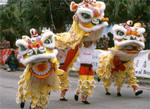|
|
| Home l Arts & Crafts l Games l Gifts l General l Just Kids l Grandparents l Suzy's Blog l Entertainment l Store l Registration l Site Map |
|
|
| Home l Arts & Crafts l Games l Gifts l General l Just Kids l Grandparents l Suzy's Blog l Entertainment l Store l Registration l Site Map |

|
The new year celebration is the most important and the longest of all Chinese festivals, traditionally lasting for two weeks. During this period, towns and villages are decorated with colored lanterns, floral displays, and brightly colored banners emblazoned with new year greetings. Preparations traditionally begin in the home the week before the new year, when families thoroughly clean their houses to symbolically sweep away all traces of misfortune. They also pay off debts, add a new coat of red paint to doors and windowpanes, and decorate the home with flowers. To avoid bad luck, parents warn their children to be on their best behavior and to avoid the use of vulgar expressions. On the evening before the new year, families gather for a feast of various dishes of seafood and dumplings. Each dish has symbolic meaning, often signifying good luck and prosperity. At midnight, families light fireworks to attract the attention of benevolent gods and to frighten away evil spirits. The fireworks last until dawn, although celebrants may sporadically light more fireworks for the next two weeks. On the first day of the new year, people put on new clothes to symbolize the discarding of the old year and its misfortunes. Then they take gifts to friends and relatives. The gifts usually include special rice flour cakes and fruits such as kumquats and oranges. Many adults, particularly married ones, also follow an ancient custom of giving small red packets of money (called hung-pao or lay shee) to children, unmarried adults, and employees or servants. Among the most spectacular festivities of Chinese new year are the dragon and lion dances. As many as 50 or more people support long paper dragons and lions while dancing in processions down city streets. The dancers perform to the beating of gongs and drums, while other celebrants perform acrobatic displays. Some of the performers may occasionally reach up to take red money packets or fruits and vegetables hung from storefronts. The celebrations end with the lantern festival, an event in which merchants hang lighted paper lanterns outside their shops. Many of the lanterns rotate with the heat of the candles they contain. Children often parade through the streets during the lantern festival, carrying lanterns of various shapes and patterns. Article courtesy of Encarta
|